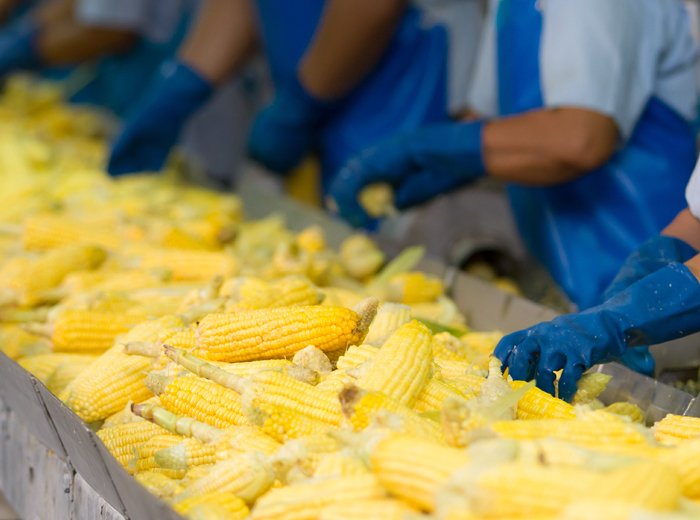Inspection of Genetically Modified Food Products
1023 Views |

Translated and Compiled By: สุกิตติมา นิทราศรีสมุทร
Sukittima Nitrasrisamoot
Writer
Food Focus Thailand Magazine
editor@foodfocusthailand.com
ผลิตภัณฑ์อาหารที่ผลิตหรือแปรรูปมาจากสิ่งมีชีวิตดัดแปรพันธุกรรม (Genetically Modified
Organisms; GMOs) ที่เรียกว่า GMF (Genetically Modified Food) ในปัจจุบันเริ่มเข้ามามีบทบาทต่อวงการอาหารและการค้าขายระหว่างประเทศ ผลิตผลของพืชที่ดัดแปรพันธุกรรม เช่น ข้าวโพด ถั่วเหลือง มันฝรั่ง มะเขือเทศ และคาโนล่า ได้รับอนุญาตให้วางจําหน่าย และถูกนําไปใช้เป็นวัตถุดิบในการผลิตอาหารที่สำคัญในปัจจุบัน แต่ผู้บริโภคบางส่วนยังมีความไม่มั่นใจว่า ผลิตภัณฑ์อาหารที่ผลิตหรือแปรรูปจากสิ่งมีชีวิตดัดแปรพันธุกรรมนี้ จะมีความปลอดภัยในการบริโภคเหมือนกับอาหารตามธรรมชาติหรือไม่ และถึงแม้มีการวิเคราะห์เปรียบเทียบด้วยวิธีการทางวิทยาศาสตร์หลายๆ วิธี แต่การทดลองส่วนใหญ่ยังไม่ครอบคลุมถึงความปลอดภัย ในการนําผลิตภัณฑ์ดัดแปรพันธุกรรมมาใช้ในระยะยาวกับผู้บริโภค
ในบางประเทศจึงออกข้อกําหนดให้มีผลการตรวจสอบ GMOs เป็นข้อมูลในการนําเข้าของสินค้า อีกทั้งการระบุบนฉลากผลิตภัณฑ์อาหาร ว่าใช้วัตถุดิบหรือมีส่วนประกอบในวัตถุดิบอย่างใดอย่างหนึ่งที่เกี่ยวข้องกับ
GMOs เพื่อแจ้งให้ผู้บริโภคทราบก่อนการตัดสินใจว่า จะเลือกใช้ผลิตภัณฑ์อาหารนั้นหรือไม่ ดังนั้นเทคนิค
การตรวจสอบ GMOs ในผลิตภัณฑ์อาหาร จึงเริ่มเข้ามามีบทบาทสำคัญในกระบวนการตรวจวิเคราะห์
องค์ประกอบของผลิตภัณฑ์ เพื่อรับรองคุณภาพสินค้าและการส่งออก
การตรวจสอบ GMOs ในผลิตภัณฑ์อาหาร
การตรวจสอบ GMOs ใช้หลักการตรวจสอบหาสารบ่งชี้ความเป็น GMOs ซึ่งก็คือ กลุ่มของหน่วย
พันธุกรรม หรือ ยีน (Gene) ที่ถูกดัดแปรไปจากสิ่งมีชีวิตปกติ การตรวจสอบความเป็น GMOs ในผลิตภัณฑ์อาหาร แบ่งออกเป็น 2 วิธี คือ
1. การตรวจวิเคราะห์เชิงคุณภาพ เป็นการตรวจสอบเพื่อให้ทราบว่าในผลิตภัณฑ์อาหารนั้นๆ มีส่วนประกอบของ GMOs หรือไม่
2. การตรวจวิเคราะห์เชิงปริมาณ เป็นการตรวจสอบเพื่อให้ทราบว่าในผลิตภัณฑ์อาหารนั้นๆ มีส่วนประกอบของ GMOs ในอัตราส่วนเท่าไรของน้ำหนักของผลิตภัณฑ์ ซึ่งในปัจจุบันสินค้า GMOs ได้รับ
อนุญาตให้วางขายได้ในหลายประเทศ ในแต่ละประเทศจะออกข้อกําหนดว่า ต้องมีสารพันธุกรรม หรือ
โปรตีนที่เป็นผลจากการดัดแปรพันธุกรรมในอัตราส่วนเท่าไรของน้ำหนักของผลิตภัณฑ์ เช่น ประเทศในสหภาพยุโรปมีข้อกําหนดให้ติดฉลากสินค้าที่มี GMOs เกินร้อยละ 1 ขณะที่ประเทศเกาหลีและญี่ปุ่นกำหนดมาตรฐานไว้ที่ร้อยละ 3 และ 5 ตามลำดับ สำหรับประเทศไทยมีข้อกําหนดให้ติดฉลากสินค้าที่มีปริมาณของ GMOs เกินร้อยละ 5
Food products produced or processed from Genetically Modified Organisms (GMOs), known as GMF (Genetically Modified Food), are now playing a role in the food industry and international trade. Produce from transgenic crops such as corn, soybeans, potatoes, tomatoes, and canola are permitted for sale and are used as raw materials in the production of important food today. But some consumers are still uncertain whether food products made or processed from transgenic organisms can be used as safe as natural food. Despite the comparative analysis of various scientific methods, most trials have failed to cover the safety of long-term consumer use of transgenic products.
In some countries, there is a requirement to have the GMO inspection results as information on the import of goods. It is also required to specify on the label of food products that the use of raw materials or components in any of the raw materials related to GMOs to inform consumers before deciding whether to choose a food product. Therefore, the detection of GMOs in food products has started to play an important role in the product composition analysis process to ensure product quality and export.
Monitoring GMOs in Food Products
Inspection of GMOs is based on the identification principle of GMOs, which is a group of units. Genetics or genes that are modified from normal living things. There are two methods for determining the presence of GMOs in food products:
1. Qualitative analysis is to check if the food product contains GMO components or not?
2. Quantitative analysis is to check to know if the food product contains GMO components in the ratio of the weight of the GMOs to the product that GMOs currently receive? GMOs products are allowed to be sold in many countries. Each country will issue a requirement that genetic material or genetically modified proteins are available in what ratio of the weight of the product. For example, EU countries have a requirement to label products with a percentage of GMOs above 1, while Korea and Japan set a standard at 3 and 5 percent, respectively. In Thailand, there is a requirement to label products with a percentage of GMOs over 5.



